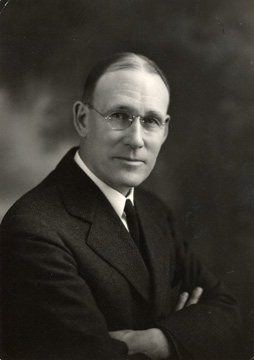Art Walk: The history and legacy of Iowa State’s portraits
December 6, 2017
When you enter the upper rotunda of Parks Library, you might notice Iowa State’s past presidents watching you. Each portrait contains a story of someone who shaped Iowa State University. Wednesday’s art walk led a group of about 30 students through the portraits residing in Parks Library and allowed them to explore the traditions of portraits at Iowa State. University Museums director Lynette Pohlman led the walk.
The portrait tradition of Iowa State began with President Raymond Hughes, who decided to commission portraits of the past presidents to commemorate and celebrate the 75th anniversary of the founding of Iowa State.
“If you start to look at their portraits, you will see clues about their lives,” Pohlman said. For example, past presidents have chosen whether they wanted to appear in academic robes or business suits, depending on how they viewed themselves.
Two important elements of a portrait are the likeness and the essence of the person. Likeness is the physical appearance of the person, while essence is what transforms a portrait from a simple image into a person who appears to be able to step out of the portrait at any moment.
One particular portrait that stands out is a portrait of former President William Beardshear. Pohlman noted different aspects of the portrait that set it apart: three-quarters of his body are in the frame, allowing for expression in the eyes, hands and angle of the body, the background fades from light to dark, and even Beardshear’s pocket watch is depicted in great detail.
Because many past presidents had already died, many artists had to create their work based on photographs, making capturing the essence of the person a difficult task. Now, each president gets their portrait painted through a series of sittings, sketches, and photographs by the artist.
Though current Iowa State president Wendy Wintersteen has taken office, her portrait hasn’t started yet – the university typically waits about two years into a president’s tenure before beginning each portrait.
Part of the process for the artist includes determining what age they should portray the president.
“We try to take them to the tenure they were president. If we can’t find a photo, we do the best we can,” Pohlman said.
The portrait tradition has continued with the recent exhibition of the Faces of Iowa State at the Brunnier Art Museum, where Iowan artist Rose Frantzen painted 39 live portraits of people who had impacted Iowa State. Pohlman said that none of the subjects had ever had their portrait painted before, and came away with their lives changed from the experience.
“It’s scary that someone can look at you for 4 hours and know you,” Pohlman said.
President Raymond Hughes’s tenure lasted throughout the Great Depression, a time where he had to fire one-third of the university staff due to lack of funds. But during this time, he also commissioned the portraits and ensured that art would be important to the university for generations to come. Art was important to him, and his commissioning of the portraits was part of university-wide search for identity.
“We needed to know who we were and how to express that. To be human is to be expressive,” Pohlman said.







